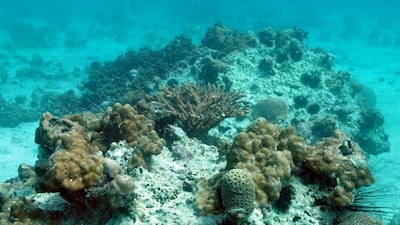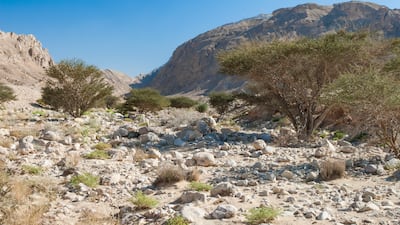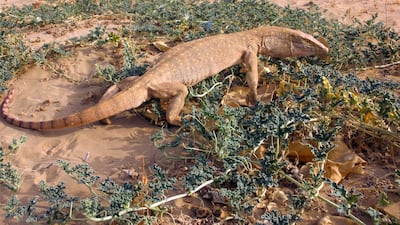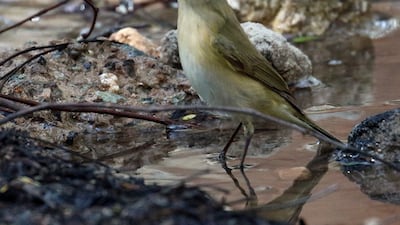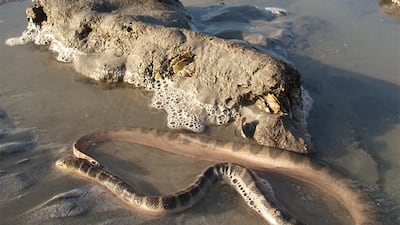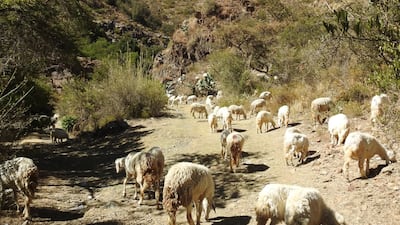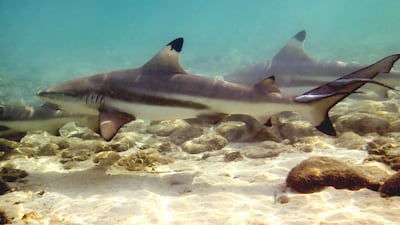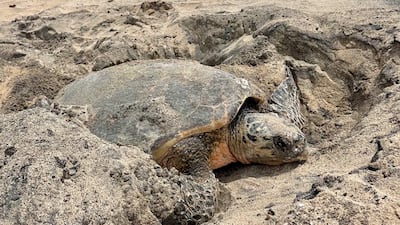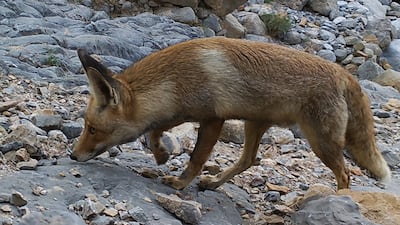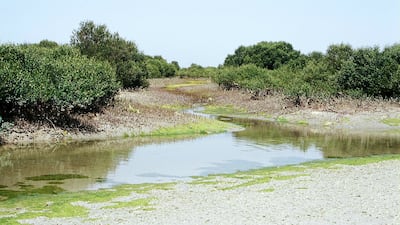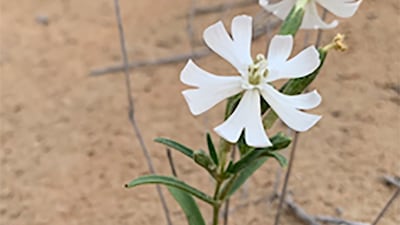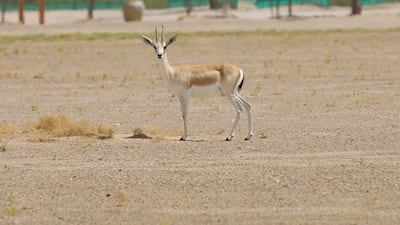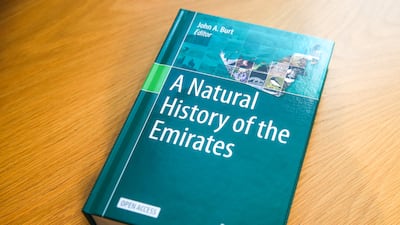Some people think of the UAE as a country only of sprawling megacities, skyscrapers and desert.
Think again. Some of the world’s most heat resistant corals lie off the UAE's coast, in waters that are also believed to be home to the world’s second-largest population of dugongs, while unique animals such as the Arabian caracal roam the UAE's mountains.
The UAE’s coastlines support mangrove forests, coral reefs, oyster beds and seagrass meadows, where marine life thrives, from sharks to turtles. The country’s wadis, mountains and sabkhas sustain plant and animal species, from the ghaf tree to the Arabian tahr, uniquely tuned to the UAE’s harsh environment.
In A Natural History of the Emirates, more than 20 experts document this vibrant and complex world, and detail the challenges it faces.

“I’m still surprised when I meet people that don’t know there are coral reefs across the UAE's coasts,” John Burt, the book’s editor and an associate professor at New York University Abu Dhabi, told The National.
“They know there are mountains on the east coast, but don’t know why they are important. For example, the mountains contain 60 per cent of all the vegetation species in the UAE even though they only make up 5 per cent of the area of the country.”
Telling the story of the UAE
Prof Burt got the idea for the book during the pandemic. With his keen interest in the UAE’s environment, Prof Burt wanted to teach a course about the country’s natural history.
But he found information was largely “scattered”, apart from the respected Tribulus journal by the Emirates National History Group, and a handful of books, such as 2005's Emirates: A Natural History, by the late Peter Hellyer and Simon Aspinall.
Mr Hellyer was also editor of Tribulus and Prof Burt's book is dedicated to him.
“There is a lot of knowledge not in that book that we know now,” notes Prof Burt. “I thought maybe it is time to put something together.”
The book, written in an accessible style, charts the rich marine life of the UAE’s coasts with its whales, dolphins, dugongs, fish, sharks and rays and reflects on how today’s cities serve as unique ecosystems in their own right with parks, water and trees providing habitats.
It outlines how resident and migrant bird communities use the Emirates as a stopover on their long-distance travels, and explores how the UAE’s mangroves work as an “ecosystem engineer” to support numerous resident and migratory species by providing food, shelter and habitats.
The book also assesses how the Arabian Gulf is one of the most extreme marine systems on earth. “We have the world’s hottest sea in the summer,” said Prof Burt. “But then it plummets 20ºC and it is freezing cold for tropical organisms in the winter. It is just crazy, the environment that is here.”
The book, which runs to more than 700 pages, also addresses the importance of the Shamal wind that comes down through the Gulf and over the UAE, helping to keep the waters a few degrees cooler. “Shamal is incredibly important in the summer because when the wind blows over the water, it is the functional equivalent of you blowing over your coffee,” he said.
The book also tracks who recorded the UAE's natural history. Consular and military figures who passed through the region were among the first to write and record.
For example, in 1840, British soldier Atkins Hamerton became the first European known to have visited Al Ain’s oasis. In the early 20th century, the famous Gazetteer author JG Lorimer documented the fish species found in the Arabian Gulf, while renowned explorer Wilfred Thesiger recorded the Arabian tahr and red foxes around Al Ain’s Jebel Hafit.
These accounts were largely “snapshots”, said Prof Burt.
Then came the 1950s oil boom. Overseas companies arrived, and people were looking for things to do at the weekend. A geologist working with an oil company in the 1960s published a paper on how the corals of the southern Arabian Gulf had the highest heat tolerance in the world.
“This was in 1964, well before we were even talking about climate change,” said Prof Burt.

Prof Burt pointed to the strong oral history of environmental knowledge among the local population, adding that this was “largely unwritten” until recently.
These records and specimens were often published and kept abroad, however, out of reach for people in the UAE. But this all changed in the 1970s with the establishment of the Emirates Natural History Group in Abu Dhabi. More people came to the UAE, explored the country during their free time, and then wrote about it.
And what is striking throughout the book is the role of these enthusiasts, many of whom have contributed chapters. Prof Burt said about 80 to 85 per cent of all knowledge of the UAE’s natural history, environment and ecosystem comes from them. Outings by ENHG members have led to numerous discoveries over the years, such as the rediscovery of the Arabian tahr on Jebel Hafit in March 1997.
The book also addresses the threats facing the natural world. Many species are critically endangered, endangered or vulnerable to extinction at the national scale. Climate change is bringing more unstable weather, while the Arabian Gulf is warming up twice as fast as the global average.

“Most organisms are living at the margins,” said Prof Burt. “If we shift this system just a degree it could potentially cause catastrophic effects.”
The book also offers solutions, from strengthening environmental policies to encouraging the use of nature-based solutions. The UAE has stepped up its efforts to protect the environment, and designated protected land and sea zones have “grown markedly” in the past decade, Prof Burt said.
There is still much to learn. The Bird Database of the Emirates grew to more than 772,000 records by 2022, from 20,000 about two decades earlier. Recent surveys of insects and other arthropods identified over 2000 species not previously known to occur in the UAE, of which over 370 were species new to science
It is not only new species that are being discovered, but also whole ecosystems. Deep-water low light coral reefs were not known to exist in the Emirates until 2022, when one was discovered 145 metres off Fujairah.
Prof Burt is a member of the ENHG, and during the two and a half year process of putting together the book, drew on contacts with academic and amateur enthusiasts. He also pointed to the significant contributions made by women.
He would like to see an Arabic edition of the book, and voiced hope that the material could be used in UAE schools.
“Even if people don’t want to read the book, it is filled with more than 440 colour illustrations that you can just flip through and go: ‘Oh, I didn’t know that was here. Look at that beautiful reef or look at that amazing gecko,'” he said.
“There are wonders across the UAE that I would just love people to be inspired to go explore.”
A Natural History of the Emirates is published by Springer and can be downloaded online for free. A physical copy should cost about Dh200
